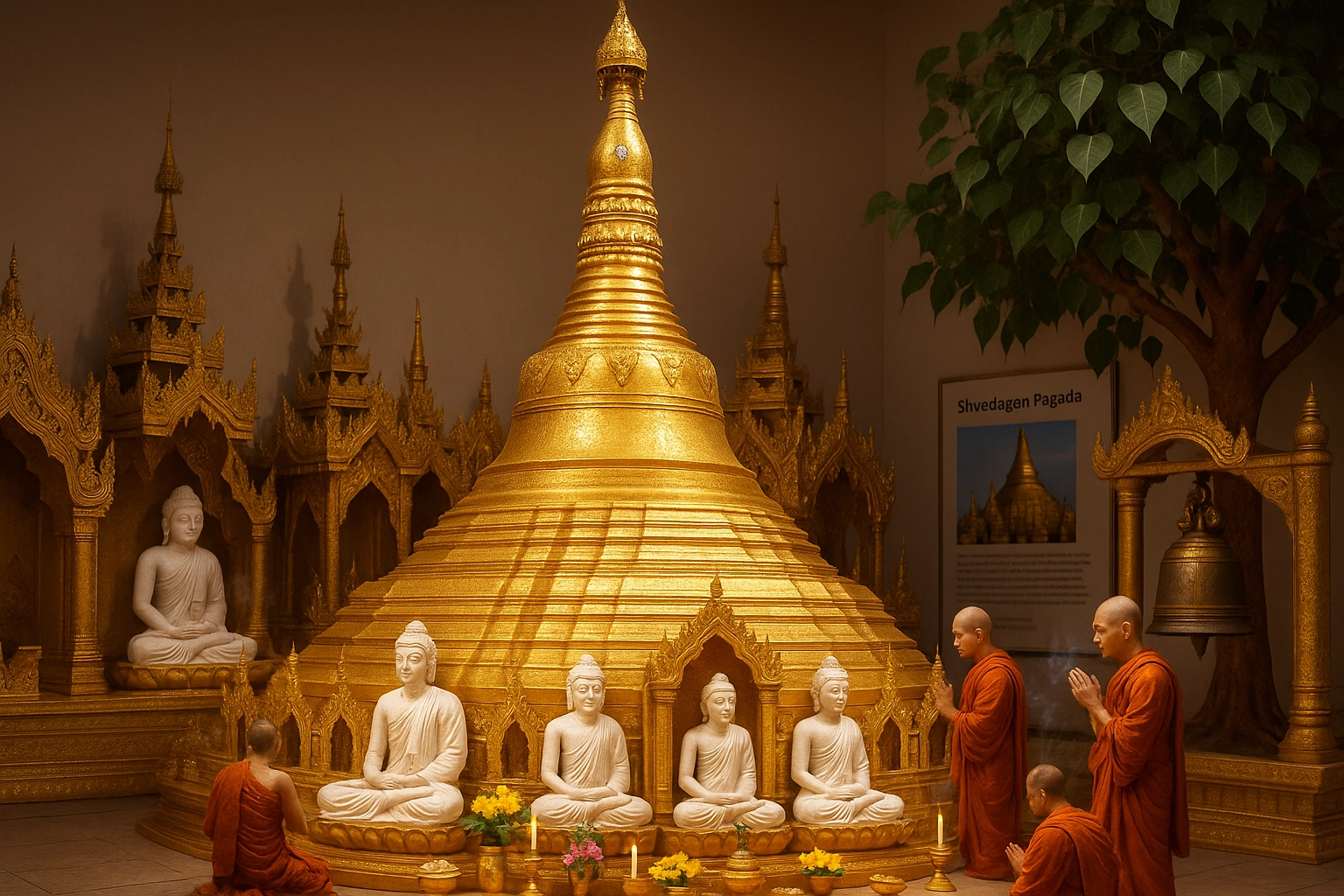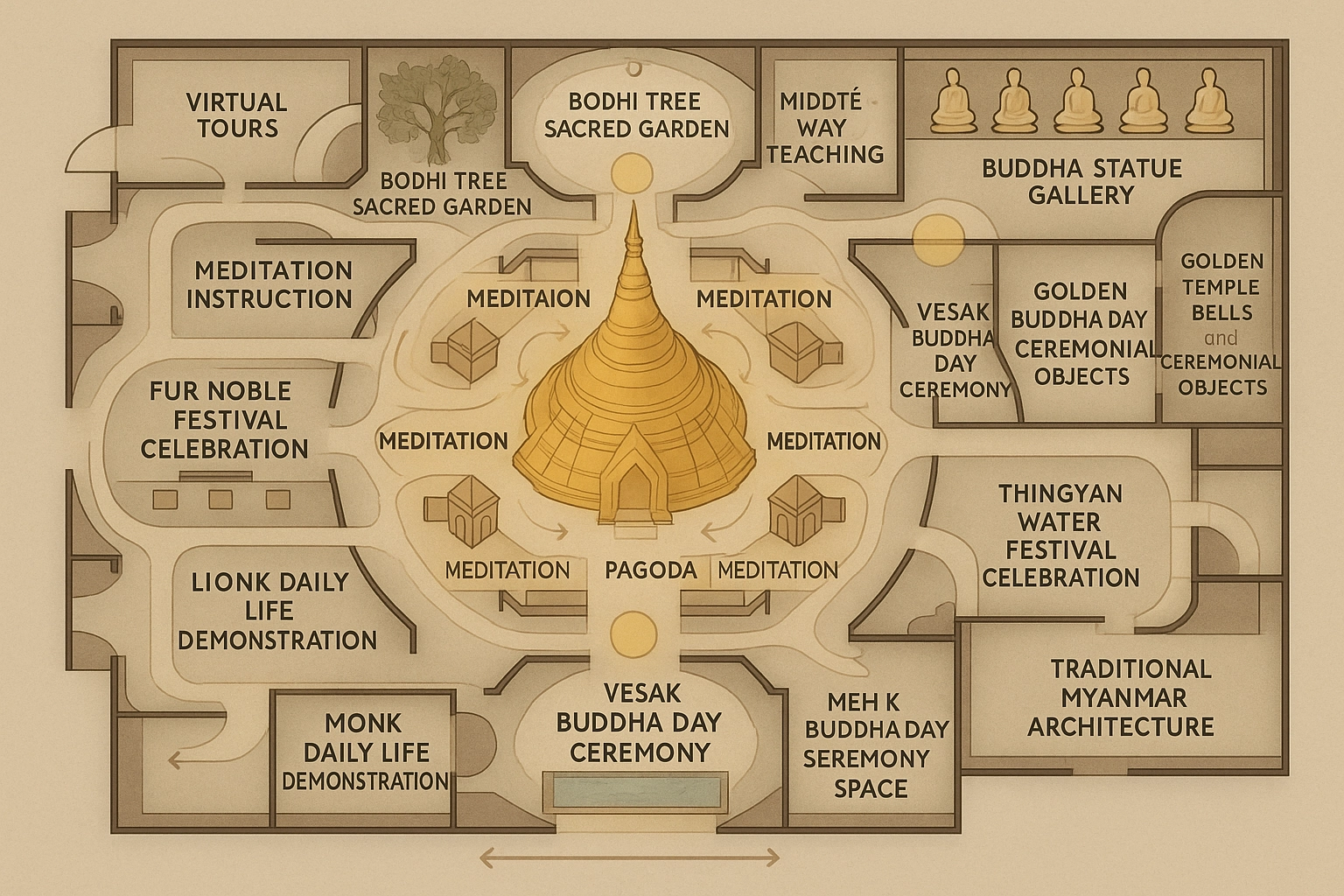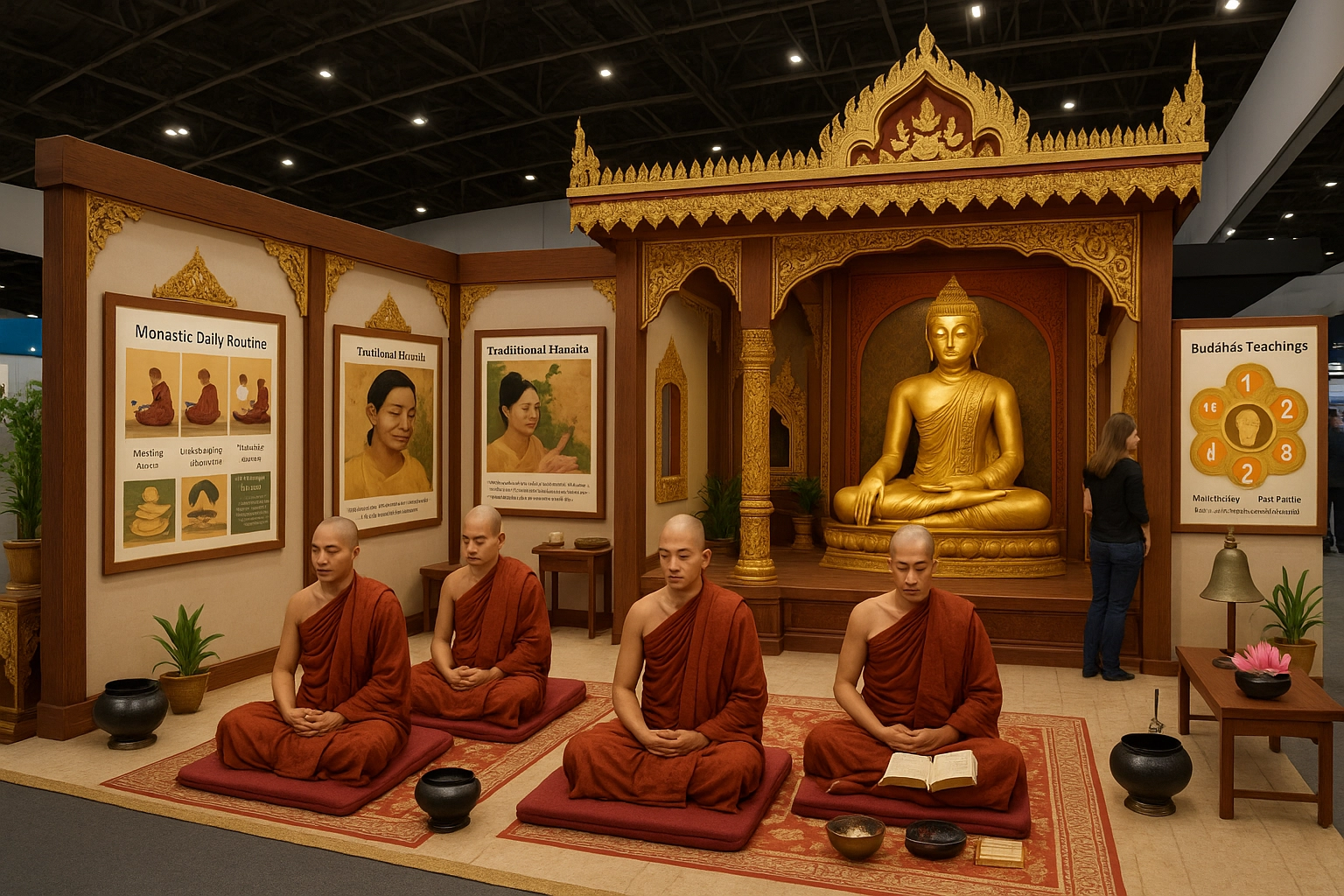Myanmar: Theravada Buddhism Exhibition
The Golden Path of Wisdom, Mindfulness, and Living Tradition - Explore the profound spiritual heritage of Myanmar's Theravada Buddhism
Exhibition Layout & Experience

Exhibition Floor Plan
Interactive layout showing meditation halls, pagoda models, and sacred relic displays

Main Exhibition Hall
Featuring golden pagoda centerpiece, Buddha statues, and Pali scripture displays

Meditation Garden
Traditional meditation space with lotus pond symbolizing purity and awakening
Historical Roots & Origins
Theravada Buddhism in Myanmar traces its origins to the 3rd century BCE, when Buddhist missionaries sent by Indian Emperor Ashoka introduced the teachings of the historical Buddha to the ancient Pyu and Mon kingdoms. Over centuries, it became deeply rooted in Burmese identity and culture.
Development & Formation
Buddhism flourished under the Pagan dynasty (11th–13th centuries), which saw the construction of thousands of pagodas and temples in Bagan. The Sangha became central to social, educational, and spiritual life, with scriptural traditions strengthened through repeated reforms and purifications.
Key Figures & Leaders
Siddhartha Gautama (Buddha)
The enlightened teacher whose teachings form the basis of Theravada doctrine.
Emperor Ashoka
Indian emperor who sent Buddhist missions to Southeast Asia, including Myanmar.
King Anawrahta
Established Theravada Buddhism as state religion, building Bagan's spiritual legacy.
Mahasi Sayadaw
Renowned modern meditation master who spread Vipassana meditation worldwide.
Core Concepts & Beliefs
Four Noble Truths
Understanding suffering, its causes, cessation, and the path to liberation.
Noble Eightfold Path
Practical guide to ethical conduct, mental discipline, and wisdom.
Three Jewels
Refuge in the Buddha, Dharma (teachings), and Sangha (community).
Mindfulness (Sati)
Continuous awareness as the key to insight and spiritual freedom.
Karma and Rebirth
Understanding actions and their consequences across lifetimes.
Non-self (Anatta)
Realization that all phenomena are without permanent essence.
Fundamental Principles
The Middle Way
Avoiding extremes of self-indulgence and self-mortification, seeking balance.
Ethical Living
Observing the Five Precepts as foundation for lay Buddhist life.
Renunciation
Monastic life dedicated to study, meditation, and service.
Merit-Making
Acts of generosity and moral conduct for spiritual advancement.
Compassion (Metta)
Cultivating loving-kindness toward all beings.
Sacred Symbols
Pagoda/Stupa
Bell-shaped monument containing relics, symbolizing Buddha's enlightenment.
Lotus Flower
Signifies purity, awakening, and spiritual beauty arising from the world.
Buddha Statues
Icons representing key moments in the Buddha's life and teachings.
Dhamma Wheel
The turning of the wheel of truth and the path to liberation.
Monk's Alms Bowl
Symbol of humility and interdependence between monastic and lay communities.
Major Rituals & Ceremonies
Circumambulation
Devotees walk clockwise around pagodas as an act of respect and mindfulness.
Alms Rounds (Pindapata)
Monks collect food from community, sustaining tradition of generosity.
Meditation Retreats
Intensive Vipassana and loving-kindness practices in monasteries.
Festival Observances
Vesak (Buddha Day), Thingyan (Water Festival), and full moon celebrations.
Temporary Ordination
Boys undergo monastic ordination, reinforcing cultural and spiritual values.
Global, Social & Historical Influence
Global Influence
Myanmar's Theravada tradition has inspired global mindfulness movements, produced internationally respected meditation masters, and contributed to peace and humanitarian efforts worldwide.
Cultural Impact
Theravada Buddhism is Myanmar's moral and cultural compass, shaping national holidays, education, social life, and responses to adversity throughout the nation's history.
Geographic Spread
Practiced throughout Myanmar as the state religion, with pagodas, monasteries, and meditation centers in every town and village, serving as a global center for Buddhist pilgrimage.
Notable Texts & Scriptures
Pali Canon (Tipitaka)
Complete collection of Theravada Buddhist scriptures, preserved in Pali
Commentaries (Atthakatha)
Scholarly explanations and interpretations of the Pali Canon
Meditation Manuals
Influential texts by modern Burmese masters like Mahasi Sayadaw
Sacred Sites & Monuments
Shwedagon Pagoda (Yangon)
The spiritual heart of Myanmar, enshrining relics of four Buddhas.
Bagan Archaeological Zone
Ancient city with over 2,000 Buddhist temples and pagodas.
Kyaiktiyo (Golden Rock)
Gravity-defying sacred boulder and pilgrimage destination.
Mahamuni Buddha Temple
Revered statue and center for Buddhist devotion in Mandalay.
Sagaing Hills
Renowned for meditation monasteries and spiritual training.
Enduring Quote
"May all beings be free from enmity, suffering, and grief. May they live in peace and happiness."— Traditional Burmese Buddhist Metta Chant